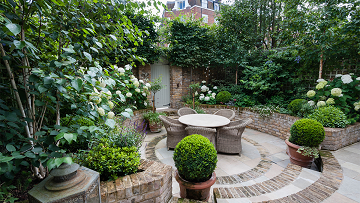By Ken Lain, the mountain gardener

We don’t know about you, but we’re more than a little ready to put this winter behind us and get outside to our garden! About this time of year, there’s a romance that comes over us when plants are budding up and leafing out. (You in colder zones, it’s coming!)
You’ve told us that you need ideas for landscaping small spaces, so we turned to the experts for the best advice. They suggested tending to our raised beds as a way to get the jump on early spring gardening.
The benefits of raised beds are many: the soil warms and dries out earlier in spring than in-ground beds, so you can plant earlier. Raised beds allow you to garden without fighting rocks or meandering roots, and the soil stays perfectly fluffy because nobody’s walking on it.
6 Tips for Preparing Raised Beds
Don’t ever, ever — walk on the soil!
The biggest advantage of raised bed gardening is the light, fluffy, absolutely perfect soil you’re able to create for planting. When you build your raised beds, build them so you’re able to reach every part of the bed without having to stand in it. If you already have a raised bed, and find that you have to walk on parts of it, consider installing strategically-placed patio pavers or boards, and step ONLY on those rather than on the soil. In the long run, this simple strategy makes a great difference to the soil.
Plan your irrigation system.
Two of the best ways to irrigate a raised bed are by soaker hose and drip irrigation. You can save a lot of time and energy and relieve the back pain that often comes from standing with a hose to water.
Keep OUT roots and weeds.
To ensure that you won’t have to deal with weeds growing up through your perfect soil, consider installing a barrier at the bottom of each bed. Do this with a commercial weed barrier, a piece of old carpet, or the left-over pink insulation used in your home. If you have an existing raised bed and find you’re battling encroaching tree roots every year, you may have to excavate the soil, install the barrier, and refill with the soil. It’s a bit of work, but well worth the peace of mind.
Top-dress annually with Potting Soil.
Gardening in a raised bed is, essentially, like gardening in a really large container. As with any container garden, the soil will settle and deplete as the season’s pass. Mitigate this depletion by adding a 1-2” layer of compost or Barnyard Manure each spring before planting.
Freshen your soil each spring.
Loosen used soil by turning it to one shovel’s depth every spring. This is the time to add fresh manure, 7-4-4 All Purpose Plant Food, bonemeal, and other nutrients needed to grow a beautiful garden. This is a task that’s decidedly easier in a raised bed than at ground level! Simply stick a garden fork as deeply into the soil as possible, and wiggle it back and forth. Do that at eight to twelve-inch intervals all over the bed, and your soil will be nicely loosened without a lot of backbreaking work. Again, resist the urge to walk on your newly enhanced garden soil! Here’s more for exact details.
Think ahead to extend the season.
A little planning up front enables you to grow earlier in the season or extend your growing season well into the autumn. Consider installing supports for a simple low tunnel or arched cold frame, and frost alerts will no longer bother your plants. I’ve even used reclaimed discarded windows and rigged them to lower as protection over raised beds.
Until next week, I’ll see you at the garden center.
Ken Lain can be found throughout the week at Watters Garden Center, 1815 W. Iron Springs Rd in Prescott, or contacted through his web site at WattersGardenCenter.com or FB.com/WattersGardenCenter

